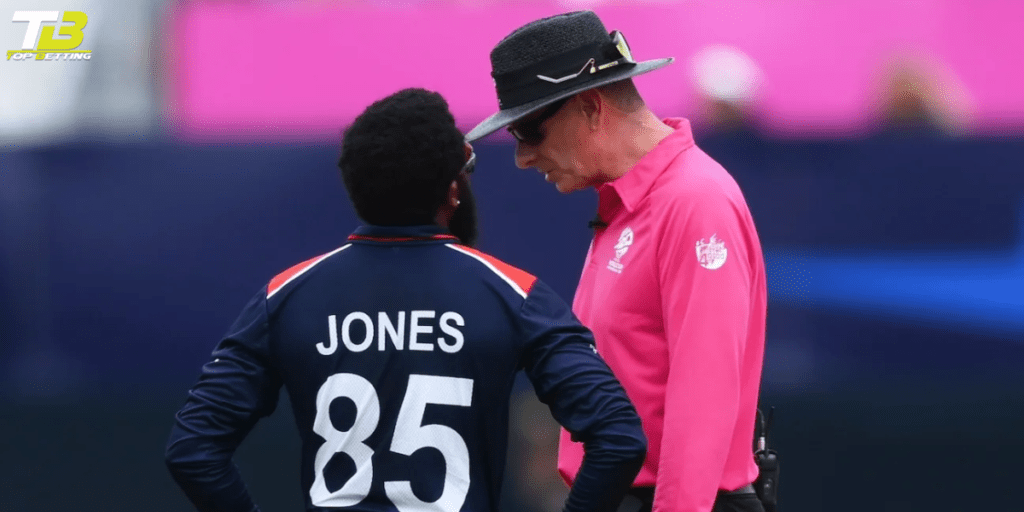
Penalty Runs Awarded to India Against the USA T20 World Cup
The T20 World Cup is a highly anticipated event that captivates cricket enthusiasts worldwide. In a recent match between India and USA, a peculiar incident unfolded that had a significant impact on the outcome of the game. As India chased down a challenging target, the umpires awarded them a crucial 5 penalty runs, shifting the momentum in their favor. This unexpected turn of events has sparked discussions and raised questions about the intricacies of cricket’s playing conditions.
The Tense Scenario
As India approached the closing stages of their run-chase against the USA, the scoreboard read 35 runs needed off 30 balls. The tension was palpable, with both teams vying for the upper hand. However, the umpires suddenly engaged in a conversation, first among themselves and then with the USA’s stand-in captain, Aaron Jones.
The Penalty Runs Awarded
After the discussion, former Australian pacer Paul Reiffel made a distinct signal, touching his left shoulder with his right arm. To the surprise of the spectators, the umpires awarded 5 penalty runs to India, instantly altering the equation to a more manageable 30 runs off 30 balls.
Understanding the Playing Conditions
The decision to award the penalty runs was based on the men’s T20I playing conditions, specifically section 41.9.4. This rule stipulates that the fielding side must be ready to start each over within 60 seconds of the previous over being completed. An electronic clock, visible to the audience, counts down the seconds from 60 to zero, indicating the time limit.
Consequences of Time-Wasting
According to the playing conditions, if the fielding side is not ready to start the next over when the clock reaches zero, the following consequences are in place:
On the first such occasion in an innings, the bowler’s end umpire shall issue a warning to the captain of the fielding side and inform the batters and the other umpire.
On the second occasion in an innings, the above sequence is repeated, but with the reminder that this is a final warning.
On the third and any subsequent occasion in an innings, the bowler’s end umpire shall award 5 Penalty runs to the batting side, informing the captain of the fielding side, the batters, and the other umpire.
It seems that the USA team was made to pay the price for their tardiness in this particular instance, as the umpires deemed them guilty of time wasting between overs.
Batting Side’s Responsibilities
It’s important to note that the playing conditions also address the responsibilities of the batting side. If the fielding side is ready to resume play within the required time, but the batting side is not, the umpires have the discretion to apply the provisions of 41.10, which deals with “Batter wasting time.”
The Outcome of the Match
In the end, the 5 penalty runs awarded to India proved to be a pivotal moment in the match. The Indian team went on to win the game by 7 wickets with 10 balls to spare, showcasing their resilience and ability to capitalize on the opportunities presented to them.
Importance of Over Rates
The incident has brought to the forefront the importance of maintaining consistent over rates in T20 cricket. The International Cricket Council (ICC) has recently announced that the stop clock system, which was previously trialed, will now become a permanent feature in men’s ODIs and T20Is between Full Members, effective from June 1. This move aims to ensure that the game’s pace is maintained and that teams adhere to the time limits set by the playing conditions.
Implications for Teams and Umpires
The implementation of the stop clock system and the strict enforcement of time-related rules have significant implications for both the teams and the umpires. Teams will need to be more mindful of their over-rate management, ensuring they are ready to start each over within the allotted time frame. Umpires, on the other hand, will be tasked with closely monitoring the clock and taking appropriate action when the fielding side fails to comply with the regulations.
Balancing Competitiveness and Fairness
The penalty runs awarded to India in the T20 World Cup match against the USA highlight the delicate balance between competitiveness and fairness in the sport. While teams strive to gain every possible advantage, the playing conditions are designed to maintain a level playing field and uphold the integrity of the game. The umpires’ role in enforcing these rules becomes crucial in ensuring that no team is unfairly disadvantaged.
Lessons Learned and Future Implications
The incident serves as a valuable lesson for all teams participating in the T20 World Cup and other major cricket tournaments. It underscores the importance of adhering to the playing conditions, managing over rates effectively, and being mindful of the potential consequences of time wasting. As the game continues to evolve, the enforcement of these rules will likely have far-reaching implications, shaping the strategies and preparations of teams as they navigate the competitive landscape of international cricket.

Conclusion
The T20 World Cup match between India and USA witnessed a pivotal moment when the umpires awarded 5 penalty runs to the Indian team. This decision, based on the playing conditions, shifted the momentum of the game and ultimately contributed to India’s victory. The incident has sparked discussions about the importance of maintaining over rates, the responsibilities of both the fielding and batting sides, and the role of umpires in ensuring fairness and integrity in the sport. As the T20 World Cup progresses, teams and fans alike will be closely watching for similar occurrences, underscoring the need for teams to be diligent in their preparations and adherence to the rules of the game.










